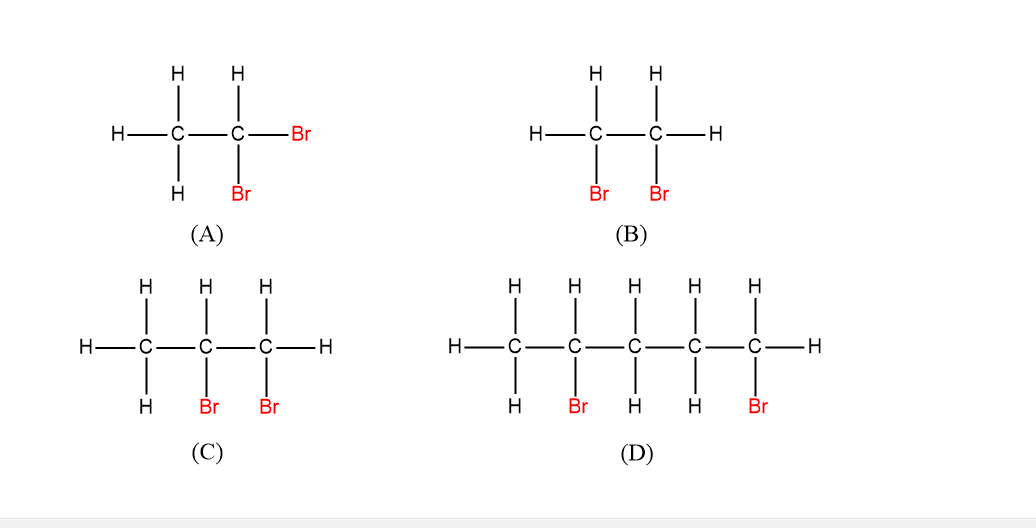
Which of the following is gem-dihalide?
Answer
405.9k+ views
1 likes
Hint: The meaning of geminal-dihalides can be understood from the name itself. Germinal means twins and dihalides mean two halogen atoms. Dihalide is the di-halogen derivative of a halogen-containing organic compound. Thus a gem-dihalide or geminal-dihalide means a compound having two same halogen atoms present on the same carbon. You can draw the structures of the given options to guess the correct answer.
Complete answer:
Gem-dihalides are organic compounds that have the same halogen atom attached to the same carbon. They are also called alkylidene halides. To guess which among the above options is a gem-dihalide we need to write their structures individually. So, let us draw the drawing of all and see which among them is the correct answer.

When we take a look at the above structures we observe that except option (A) in all the other options the halogen atom ‘Br’ is the same but it is attached to two different carbon atoms. In option (B) and (C) it is attached to adjacent carbons that is carbon number
We see that in options (B) and (C) the Br group is attached to the adjacent carbons; such chemical compounds where the two same halogens are attached to adjacent carbons are called the vicinal-dihalides. These are formed when there is a reaction between a halogen and alkene.
Therefore the correct option is
Note:
Geminal dihalides are prepared by the addition reaction of vinyl halide. When vinyl halide undergoes an additional reaction with hydrogen chloride then the formation of geminal dihalide takes place. Geminal di-halides and vicinal-dihalides are important concepts in organic chemistry.
Complete answer:
Gem-dihalides are organic compounds that have the same halogen atom attached to the same carbon. They are also called alkylidene halides. To guess which among the above options is a gem-dihalide we need to write their structures individually. So, let us draw the drawing of all and see which among them is the correct answer.

When we take a look at the above structures we observe that except option (A) in all the other options the halogen atom ‘Br’ is the same but it is attached to two different carbon atoms. In option (B) and (C) it is attached to adjacent carbons that is carbon number
We see that in options (B) and (C) the Br group is attached to the adjacent carbons; such chemical compounds where the two same halogens are attached to adjacent carbons are called the vicinal-dihalides. These are formed when there is a reaction between a halogen and alkene.
Therefore the correct option is
Note:
Geminal dihalides are prepared by the addition reaction of vinyl halide. When vinyl halide undergoes an additional reaction with hydrogen chloride then the formation of geminal dihalide takes place. Geminal di-halides and vicinal-dihalides are important concepts in organic chemistry.
Latest Vedantu courses for you
Grade 11 Science PCM | CBSE | SCHOOL | English
CBSE (2025-26)
School Full course for CBSE students
₹41,848 per year
Recently Updated Pages
Master Class 11 Economics: Engaging Questions & Answers for Success

Master Class 11 Business Studies: Engaging Questions & Answers for Success

Master Class 11 Accountancy: Engaging Questions & Answers for Success

Master Class 11 English: Engaging Questions & Answers for Success

Master Class 11 Computer Science: Engaging Questions & Answers for Success

Master Class 11 Maths: Engaging Questions & Answers for Success

Trending doubts
State and prove Bernoullis theorem class 11 physics CBSE

1 ton equals to A 100 kg B 1000 kg C 10 kg D 10000 class 11 physics CBSE

State the laws of reflection of light

One Metric ton is equal to kg A 10000 B 1000 C 100 class 11 physics CBSE

1 Quintal is equal to a 110 kg b 10 kg c 100kg d 1000 class 11 physics CBSE

Difference Between Prokaryotic Cells and Eukaryotic Cells




